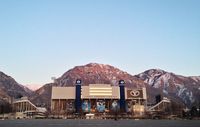LaVell Edwards Stadium
| Capacity | 63 470 |
|---|---|
| Country | United States of America |
| City | Provo |
| Clubs | BYU Cougars |
| Other names | Cougar Stadium (1964–2000) |
| Inauguration | 02/10/1964 |
| Construction | 10/1963 - 09/1964 |
| Renovations | 1967, 1982, 2003, 2010 |
| Record attendance | 66,247 (BYU Cougars - Notre Dame Fighting Irish, 1993) |
| Design | Fred L. Markham |
| Address | 1700 N Canyon Rd, Provo, UT 84604, USA |
Advertisement
LaVell Edwards Stadium – stadium description
North of the campus and city, with Utah Lake in the west and Rocky Mountains in the east – in this precious location Brigham Young University opened their new football stadium in 1964. Initially the Cougars home ground had two grandstands along the sides and a running track. However, temporary additional seating was set up quickly to accommodate additional fans. So it was under 30,000 permanent seats and over 15,000 temporary in such layout.
Huge changes came in 1982, when the running track was removed. This allowed the creation of 6 additional front rows between existing stands and the field. But more importantly, lack of curved track on both ends enabled erection of both end zones, which brought capacity to roughly 65,000.
The stadium hadn’t grown since that time. Quite the opposite, it shrunk slightly with installation of club seating in the east and places for the disabled. What hasn’t changed is the tallest part of the stadium, the 10-storey main building with press box, which offers a spectacular view of the mountains.
Until 2000 and for some to this day the stadium is commonly known as Cougars Stadium. But official name was changed to honour BYU Cougars legendary coach LaVell Edwards. Edwards became assistant coach at BYU back in 1962, before the stadium was even built. Since then he spent his entire career, 38 years, with the team.
Advertisement
Pictures
-

14.03.2015 © Pastelitodepapa (cc: by) 
08.08.2014 © seanmugs 
03.08.2013 © Jimmy Emerson, DVM (cc: by-nc-nd) 
03.08.2013 © Jimmy Emerson, DVM (cc: by-nc-nd) 
03.08.2013 © Jimmy Emerson, DVM (cc: by-nc-nd) 
03.08.2013 © Jimmy Emerson, DVM (cc: by-nc-nd) 
12.10.2012 © Jerry Ray 
25.09.2010 © Ken Lund (cc: by-sa) 
25.09.2010 © Ken Lund (cc: by-sa)

 StadiumDB
StadiumDB